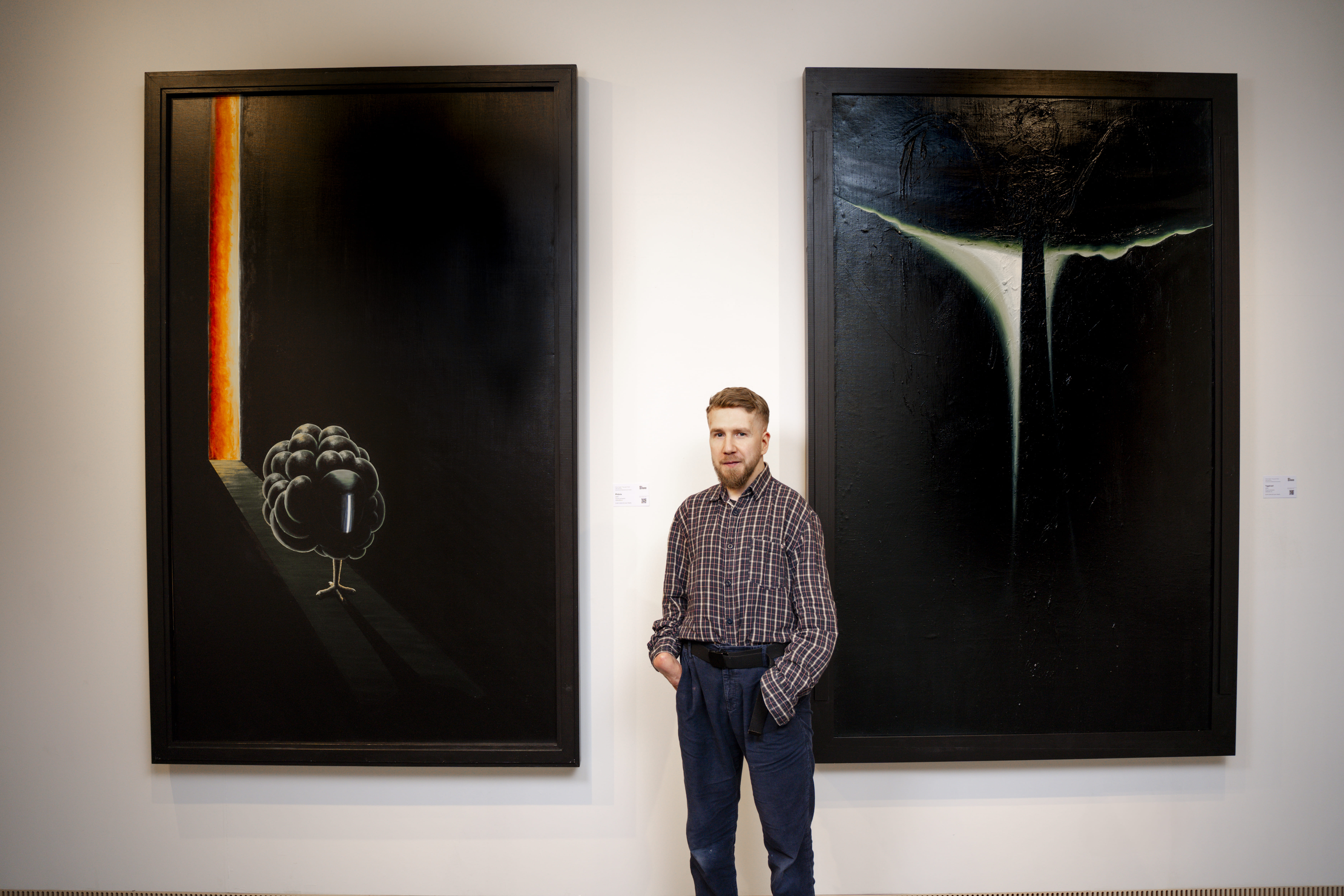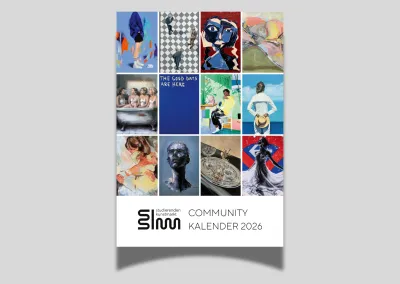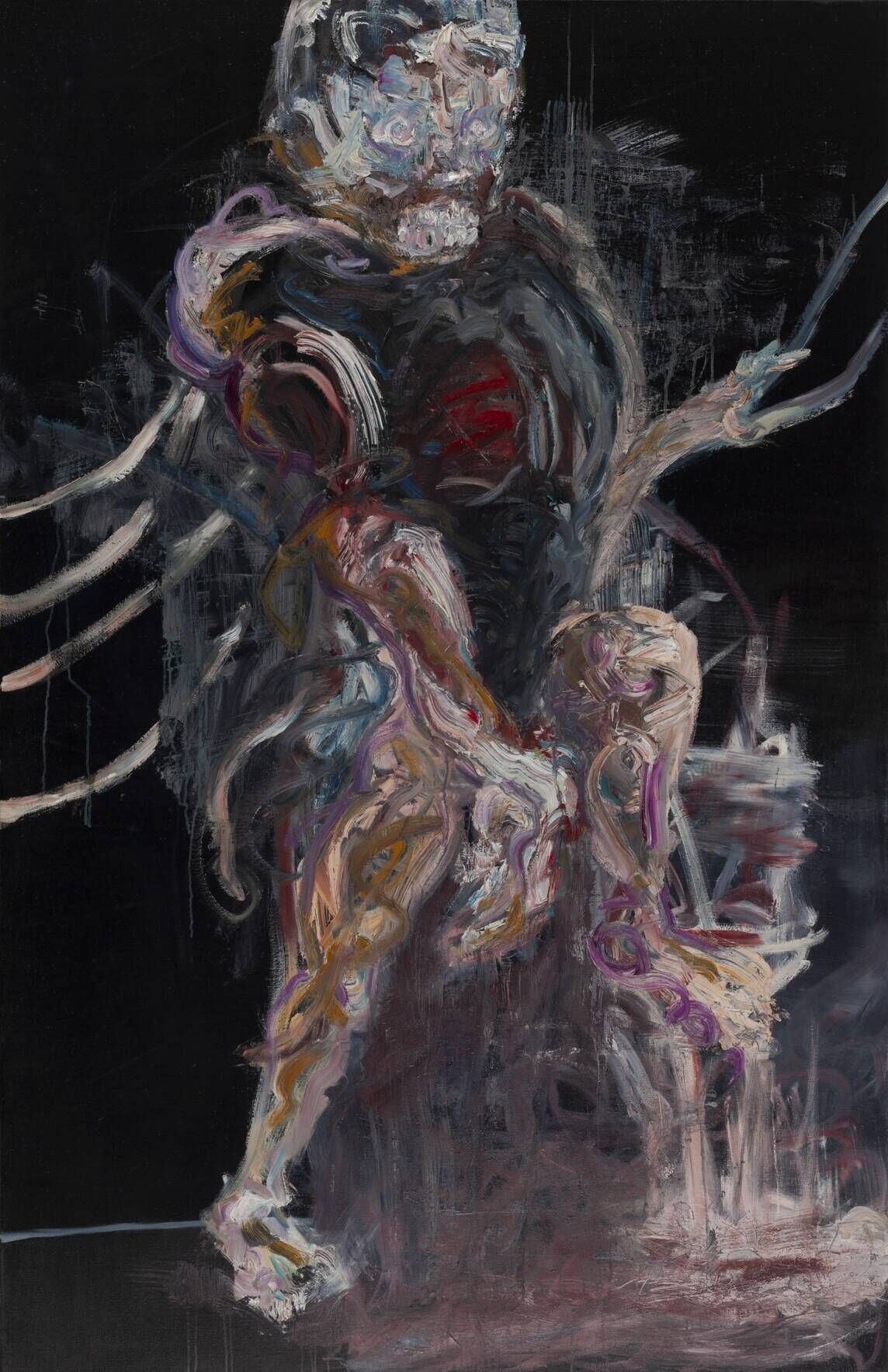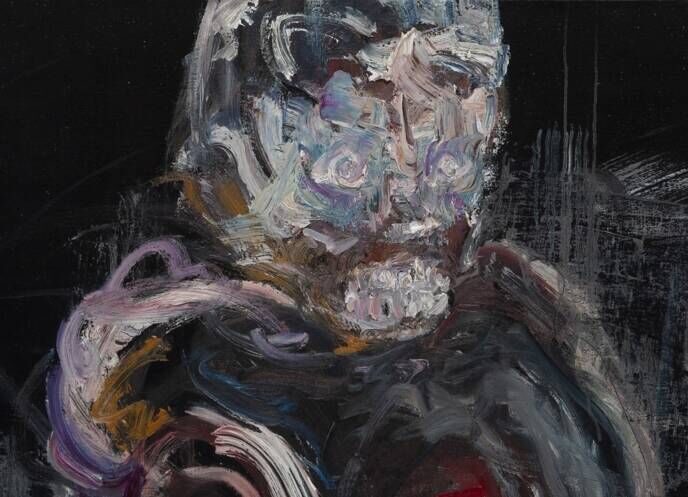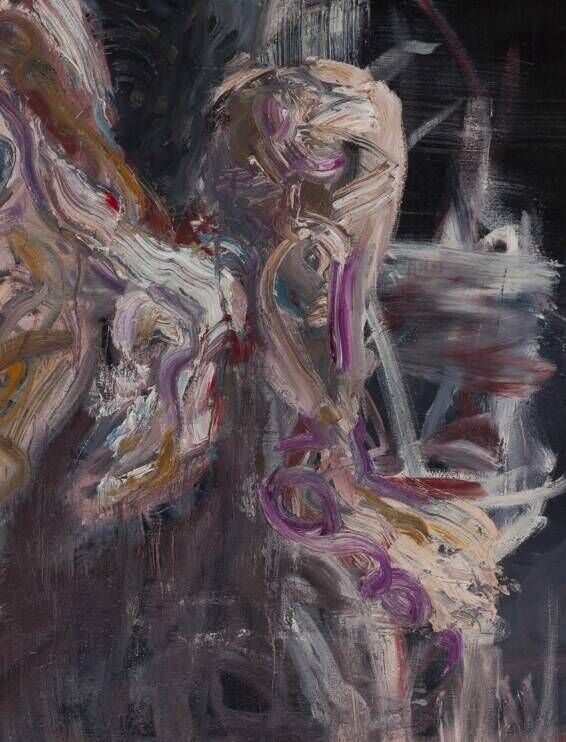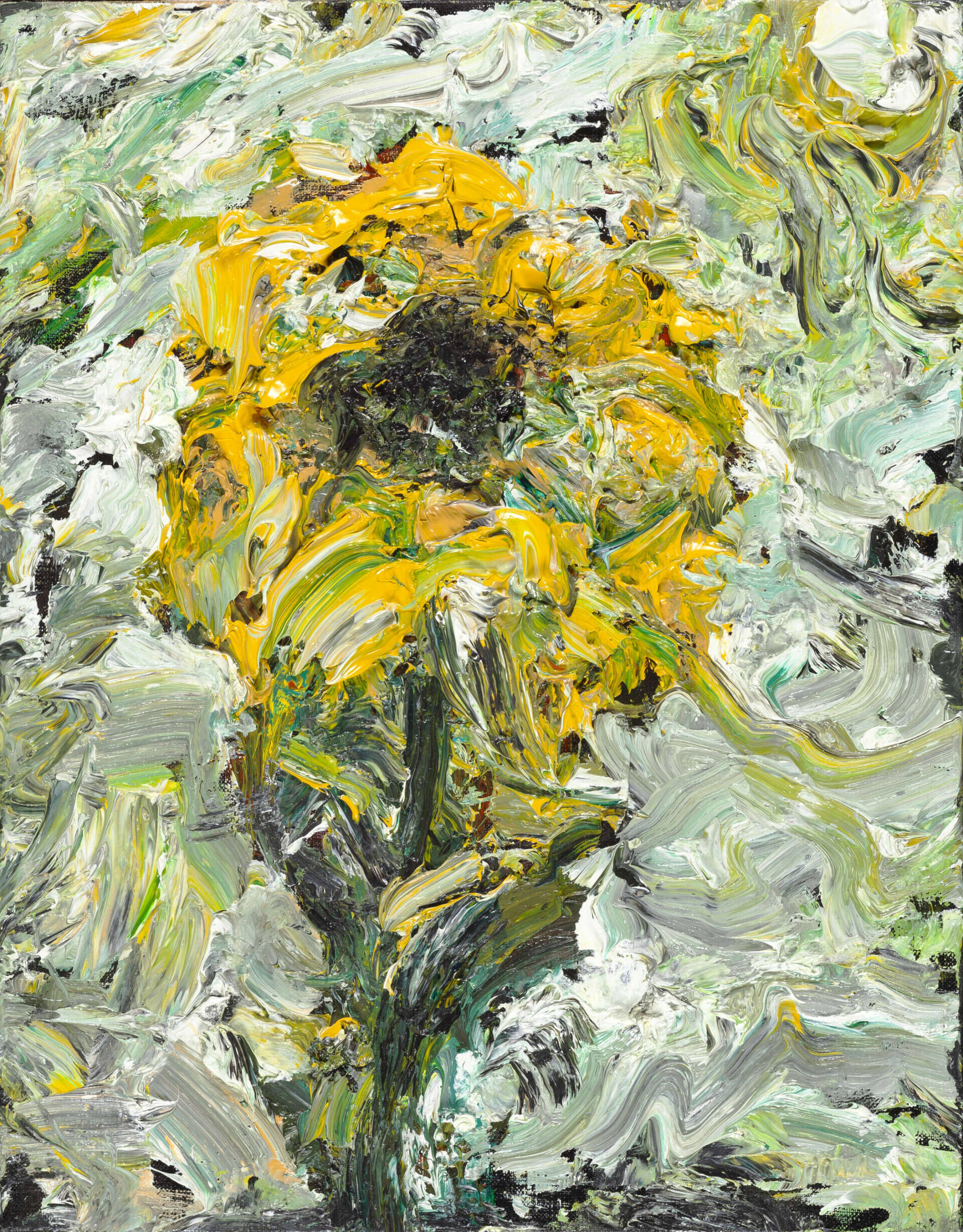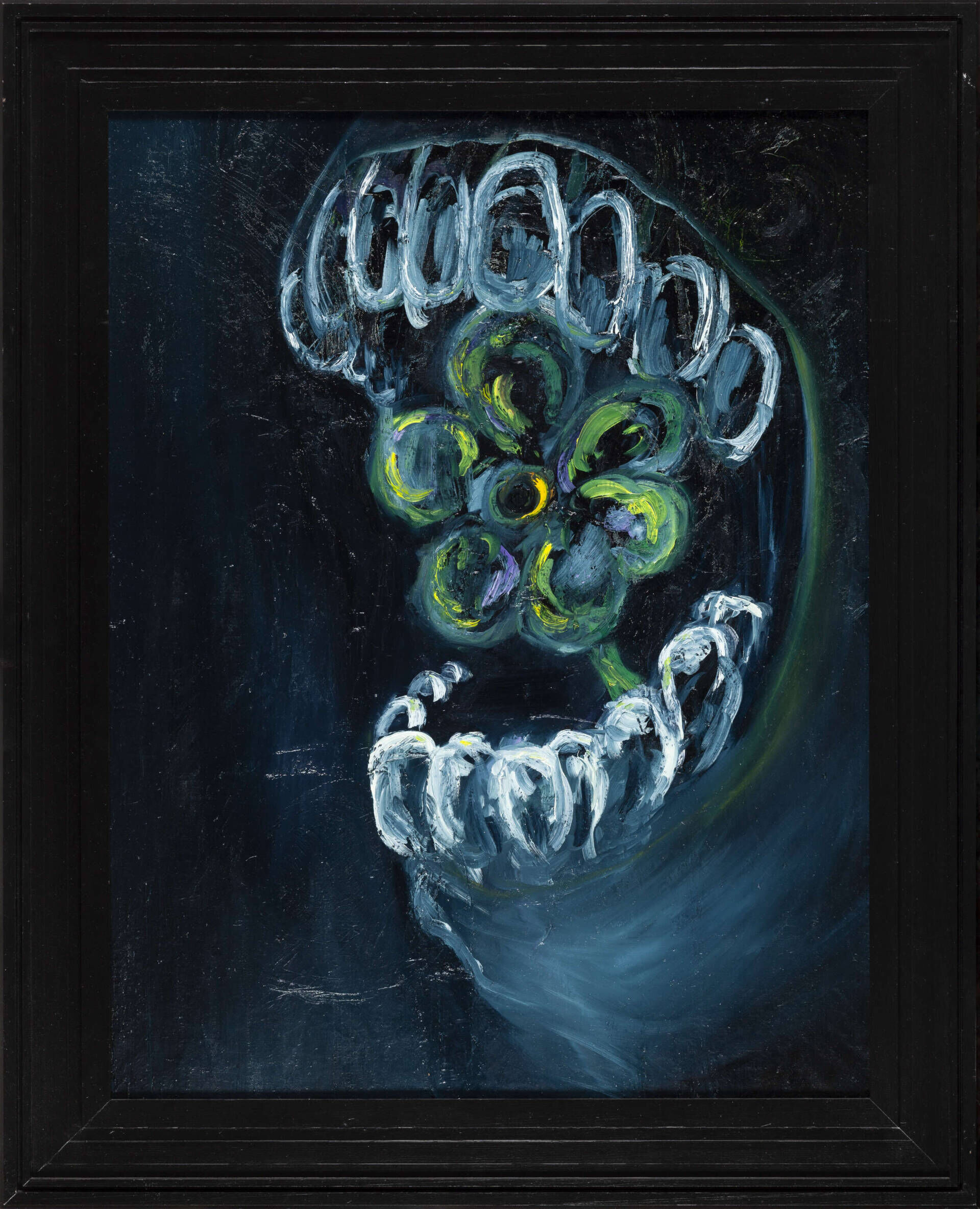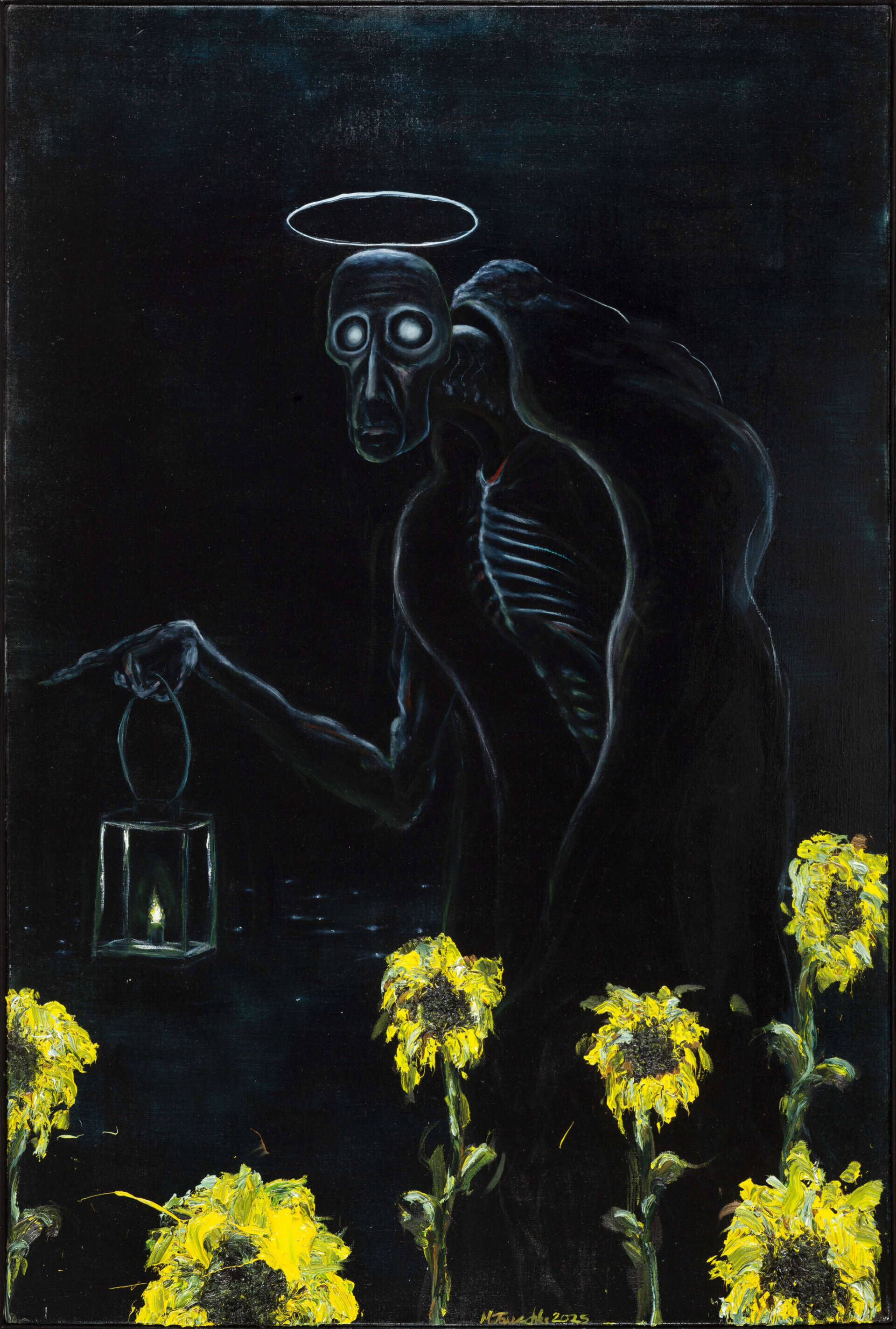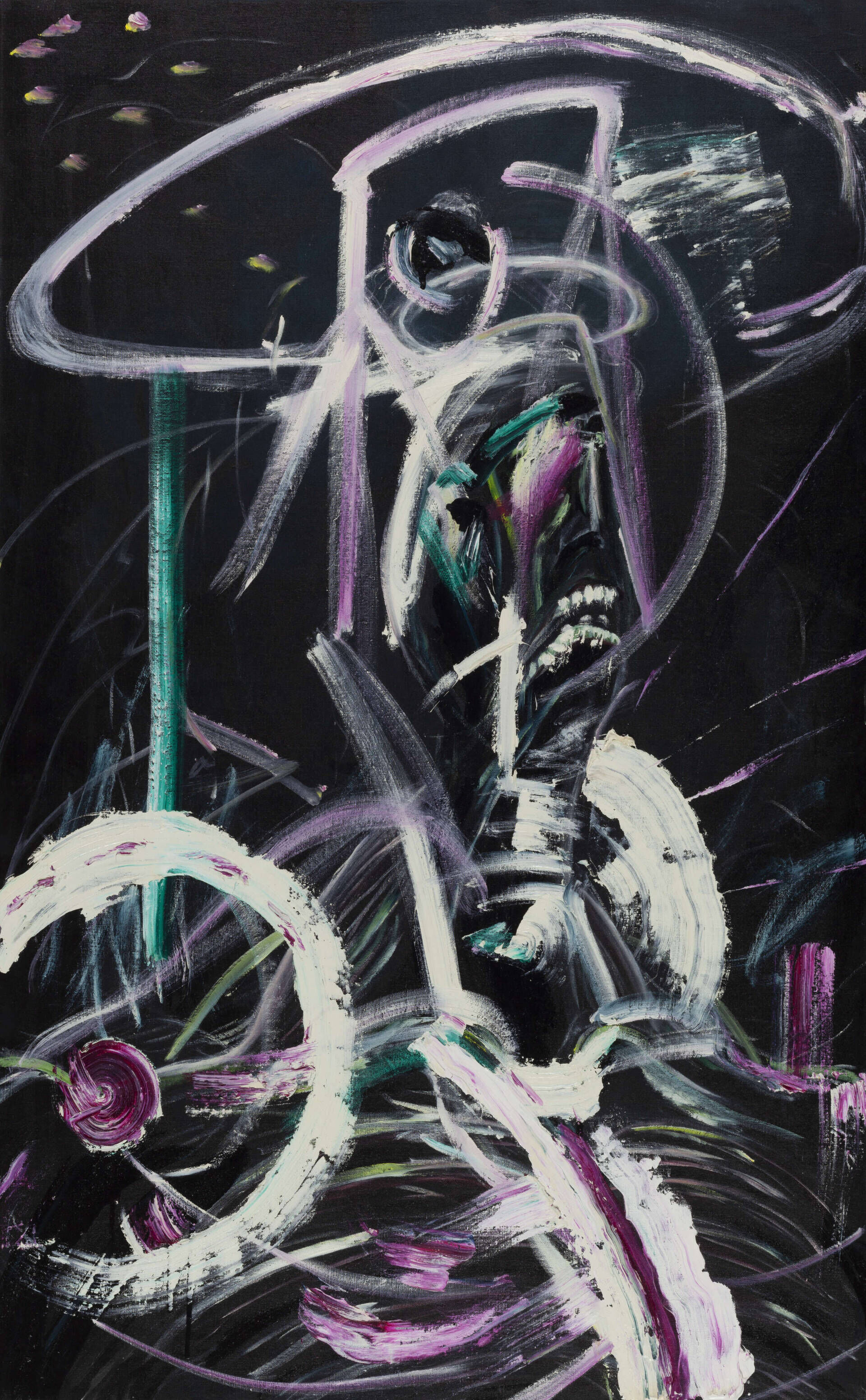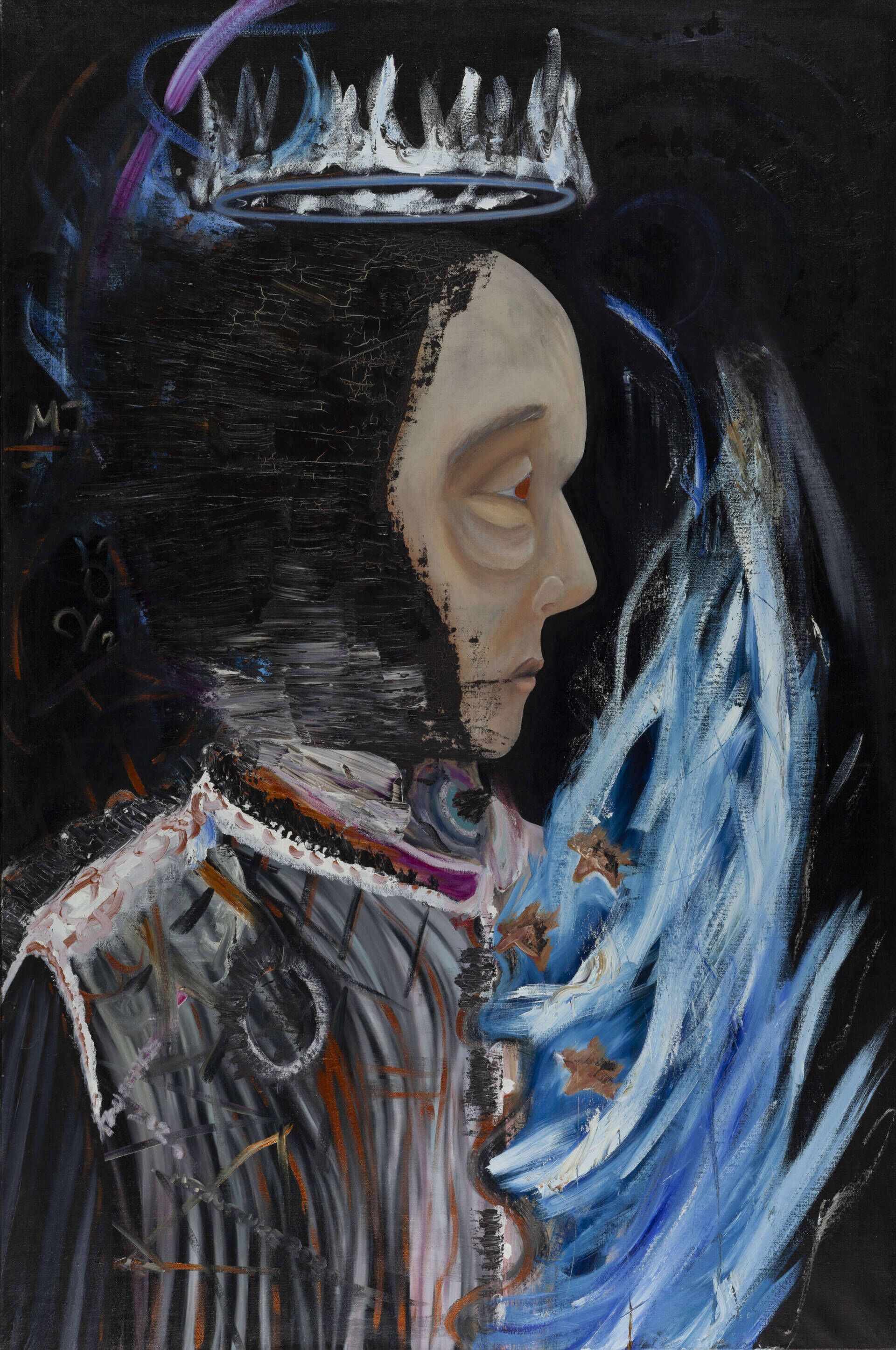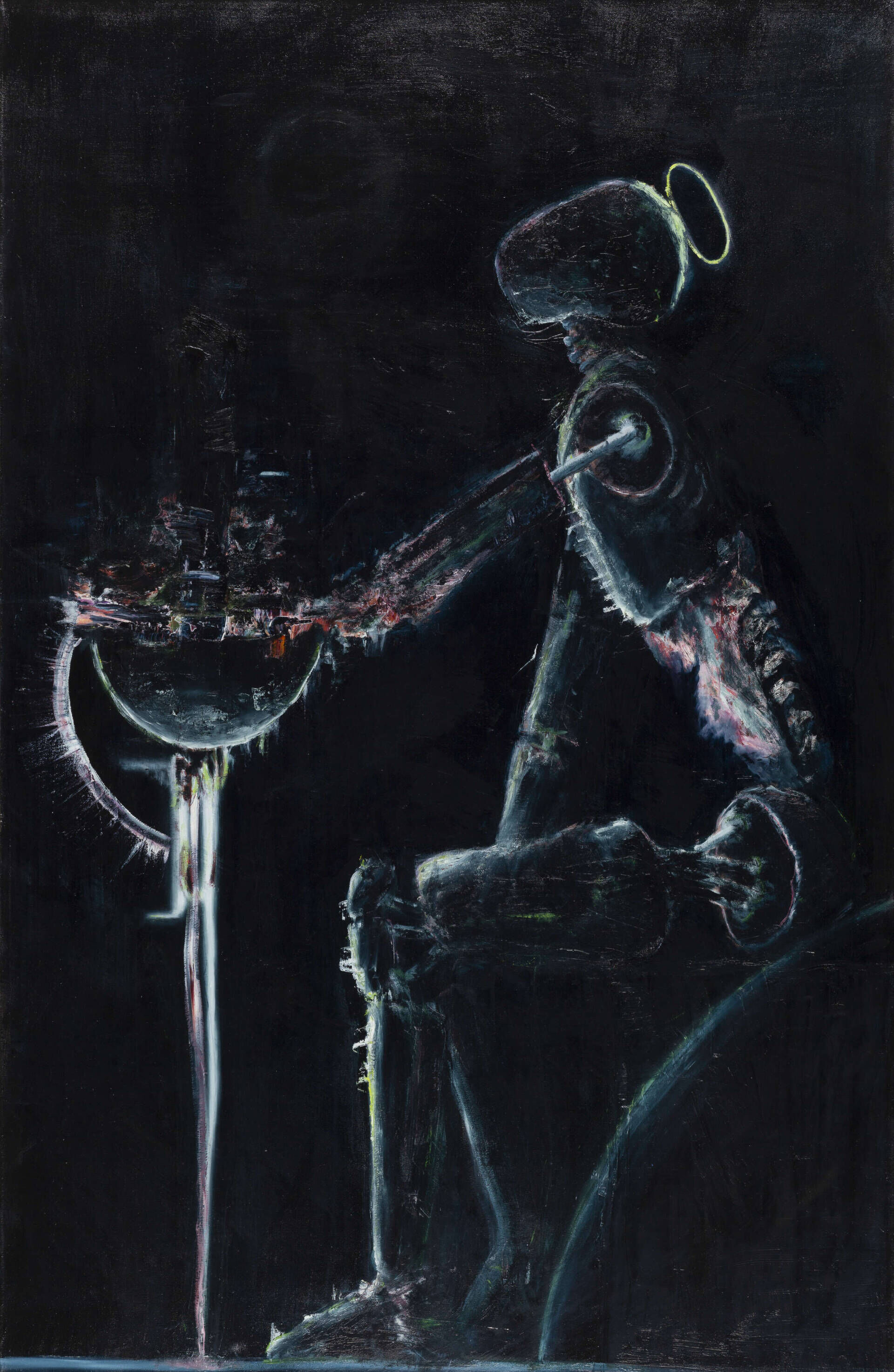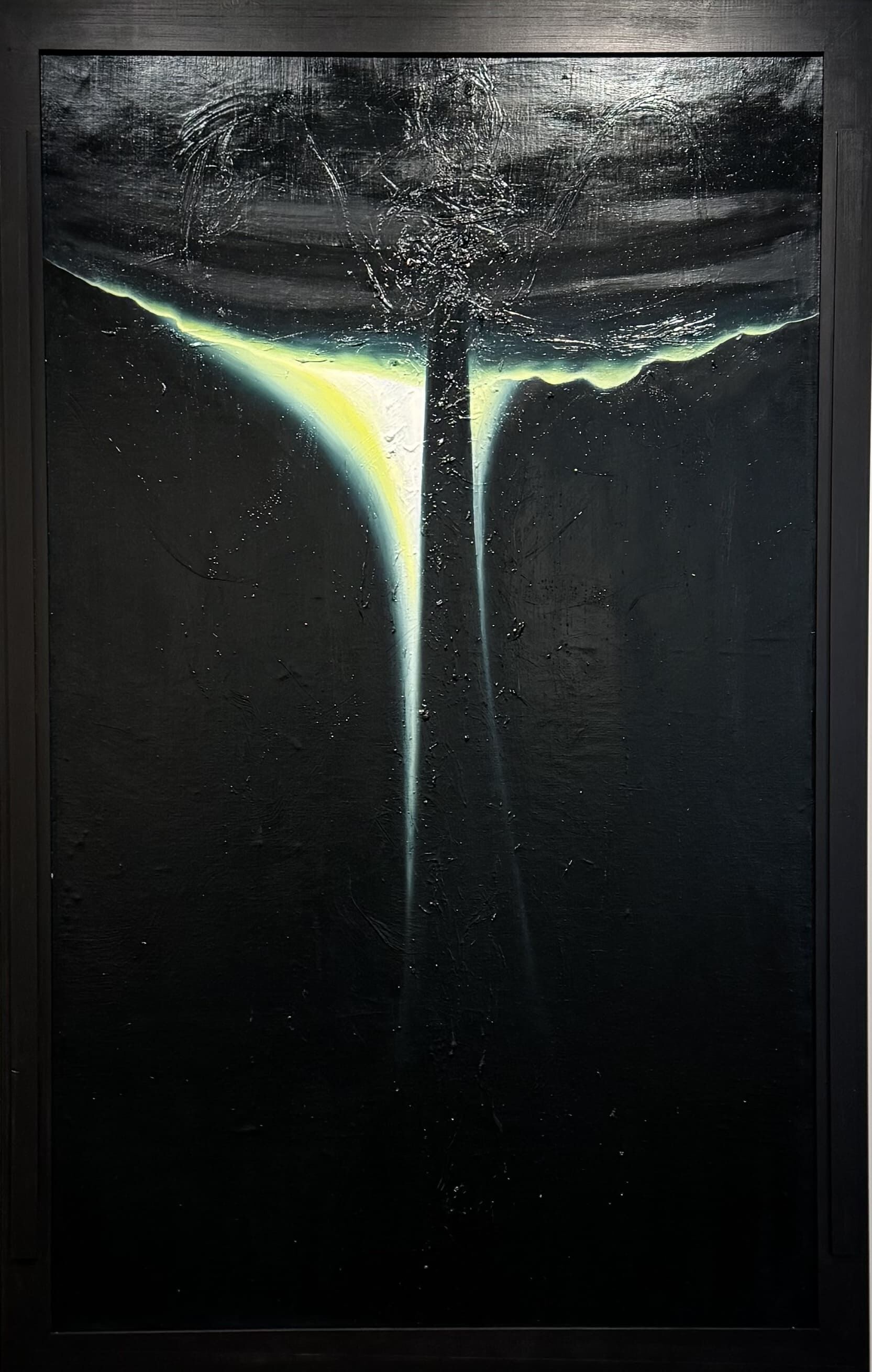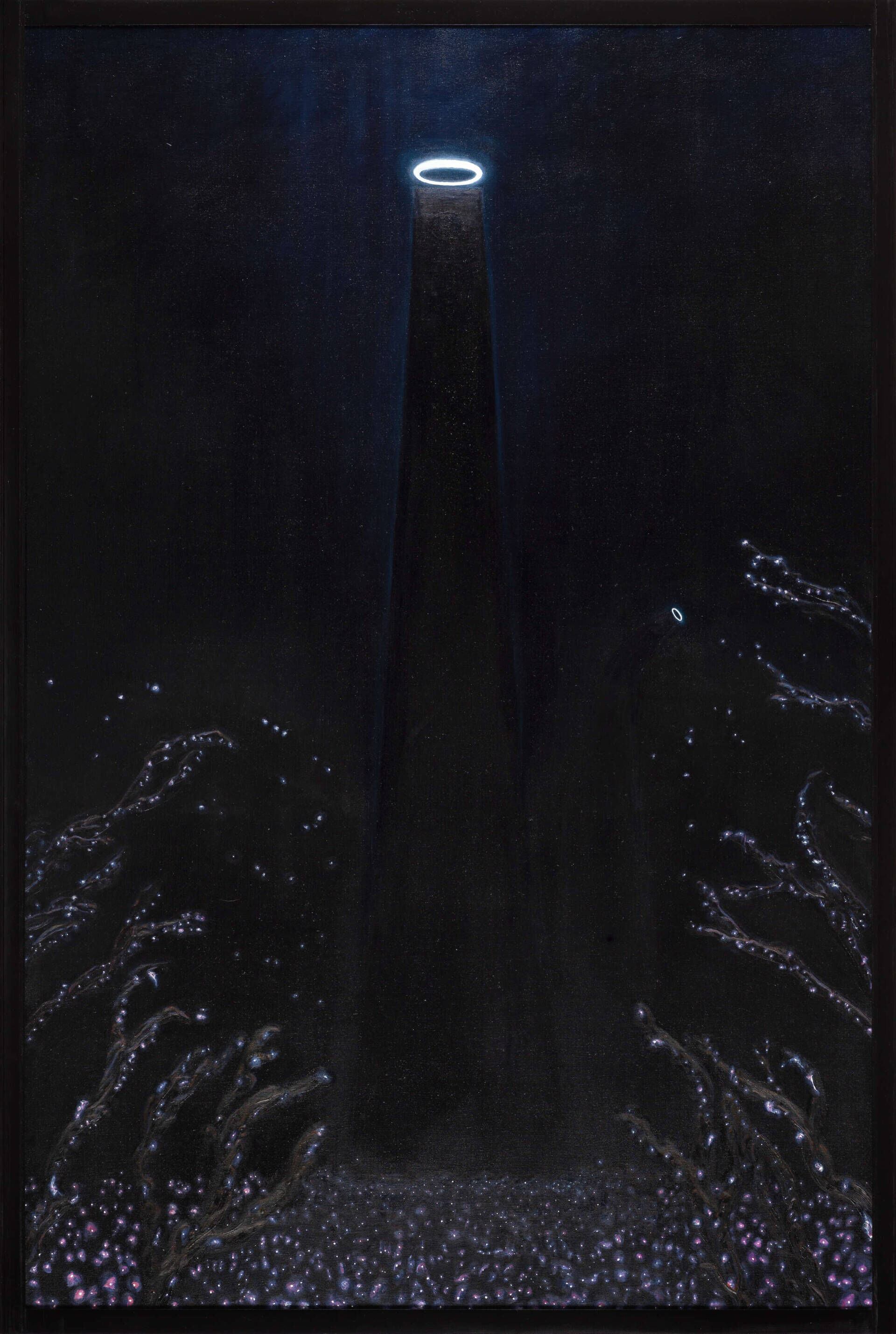KUBARK
| Heigth | 200 cm |
|---|---|
| Width | 130 cm |
| Length/Depth | 6 cm |
Das Bild wurde in meiner Wohnung gemalt, wo es auf einer Staffelei beinahe bis zur Zimmerdecke reichte. Ursprünglich zeigte die Leinwand weniger pastose, figürliche Kompositionen, die im Laufe des Malprozesses von einer zunehmend expressiven und gestischen Malweise verdrängt wurden. Diese Entwicklung spiegelte die emotionale Intensität und Dynamik wider, die das Werk prägt.
Ein entscheidender Moment war die unerwartete „Intervention“ einer Fliege. Sie schwirrte durch den Raum und näherte sich des Öfteren gefährlich dem Bild, während ich mich mit viel Geduld dem Modellieren des Gesichts der Figur widmete. Just in dem Moment, als das Gesicht und somit das Bild fertig gemalt waren, flog die Fliege direkt ins Auge der gemalten Figur und hinterließ eine verunstaltende Spur. Zu meinem Bedauern war die Fliege nicht mehr zu retten. Ihr Ableben und das verunstaltete Auge mündeten in Frustration und einem Wutanfall, der zu einer radikalen Überarbeitung des Gesichts in seine jetzige Form führte.
Dieses Ereignis, ebenso zufällig wie bedeutungsvoll, fügt dem Werk eine weitere Ebene hinzu. Es unterstreicht die Unvorhersehbarkeit und das rohe, emotionale Engagement, das in die Entstehung des Bildes eingeflossen ist. Die Textur der Malerei und die expressiven Pinselstriche reflektieren nicht nur den inneren Konflikt, sondern auch die zerstörerische Kraft psychologischer Einflüsse, die das zentrale Thema des Werkes darstellt.
Das Ergebnis ist ein Werk, das sowohl durch seine Entstehungsgeschichte als auch durch seine visuelle Präsenz, einen authentischer Ausdruck emotionaler und konzeptueller Auseinandersetzung darstellt.
KUBARK, 2020, 200 x 130 x 6 cm, Öl auf Leinwand
Englisch:
The work "KUBARK" was created during an intense engagement with the topic of "white torture" or psychological torture. It was not born out of inspiration but rather developed under the impact of this distressing subject. The title "KUBARK" refers to a CIA manual designed as a guide for interrogators, providing detailed instructions on the application of psychological torture methods—a direct reference to the depth and gravity of the theme.
The painting was created in my apartment, where it stood on an easel that nearly reached the ceiling. Initially, the canvas featured less impasto and more figurative compositions, which were gradually replaced during the painting process by an increasingly expressive and gestural style. This evolution reflects the emotional intensity and dynamism that define the work.
A decisive moment was the unexpected "intervention" of a fly. It buzzed around the room and frequently came dangerously close to the painting as I patiently worked on modeling the face of the figure. Just as the face—and therefore the painting—was completed, the fly landed directly in the painted figure’s eye, leaving a disfiguring mark. To my regret, the fly could not be saved. Its demise and the disfigured eye led to frustration and an outburst of anger, resulting in a radical reworking of the face into its current form.
This incident, as accidental as it was meaningful, adds another layer to the work. It underscores the unpredictability and raw emotional engagement that went into its creation. The texture of the painting and its expressive brushstrokes reflect not only the artist’s inner conflict but also the destructive power of psychological influences, which is the central theme of the piece.
The result is a work that, through both its creation story and visual presence, represents an authentic expression of emotional and conceptual confrontation.
KUBARK, 2020, 200 x 130 x 6 cm, oil on canvas
Michael Tauschke
Eine Reise durch das Unbekannte
Die künstlerische Praxis von Michael Tauschke bewegt sich im Spannungsfeld zwischen
Wahrnehmung, Technologie und existenzieller Erfahrung. Seine Arbeiten erforschen die Übergänge
zwischen Licht und Dunkel, Leben und Vergänglichkeit sowie zwischen der natürlichen und künstlichen
Welt.
Tauschkes Malerei und installative Arbeiten zeichnen sich durch eine vielschichtige
Auseinandersetzung mit organischen, figürlichen und symbolischen Motiven aus. Dabei steht
weniger das Sichtbare im Vordergrund als vielmehr die verborgenen Strukturen und Prozesse, die
das Leben bestimmen.
In seinen technologiebasierten Projekten werden biologische und physiologische Parameter – wie
Atmung, Herzschlag oder Wachstum – in visuelle Formen übersetzt. Auf diese Weise macht
Tauschke unsichtbare Abläufe erfahrbar und verweist auf die fragile Balance zwischen Körper,
Technologie und Bewusstsein.
Seine malerischen Arbeiten verbinden symbolische, geistige und wissenschaftliche Bildwelten.
Wiederkehrende Motive – etwa die Blume, mythologische Figuren oder der menschliche Körper –
fungieren als Schnittstellen zwischen Materiellem und Geistigem.
Tauschkes Werk versteht sich als Untersuchung des Lebens – als Suche nach Ordnung und nach
Sinn in der Ambivalenz.
Seit 2024 Meisterschülerstudium an der HfBK Dresden bei Christan Sery.
Ausstellungen
2025 Kunstmesse NEUE ArT: Mix & Match
(Gruppenausstellung), Dresden
2025 University Art Biennial: Art Week 2025
(Biennale), Mallorca, Spanien
2025 SKM Galerie Leipzig: 5. SKM Community Ausstellung April 2025
(Gruppenausstellung), Leipzig
2025 Hole of Fame: Organische Existenzen
(Gruppenausstellung), Dresden
2024 Künstlerhaus Loschwitz: AusChecken
(Einzelausstellung), Dresden
2024 Kirche Dannenwalde: Das Heilige und das Profane
(Gruppenausstellung), Dannenwalde
2024 Dresdner Sezession 89 e.V. / galerie drei: Alles Liebe, Deine…
(Gruppenausstellung), Dresden
2023 Galerie Holger John: Bilderladen
(Gruppenausstellung), Dresden
2021 Urban ShiDD: Zorn auf Leinwaqnd
(Einzelausstellung), Dresden
2020 Landesamt für Verkehr und Straßenbau: Abgefahren
(Gruppenausstellung), Dresden
2018 HfBK Dresden Senatssaal: Ausstellung
(Gruppenausstellung), Dresden
2017 Verkehrsmuseum Dresden: Gruppenausstellung der Orientierungsphase
(Gruppenausstellung), Dresden
Stipendien
2024 Arras-Stipendium
